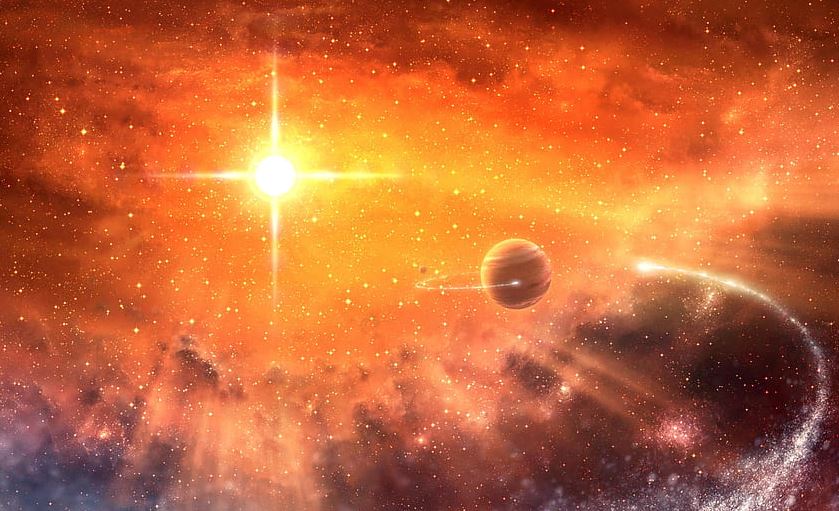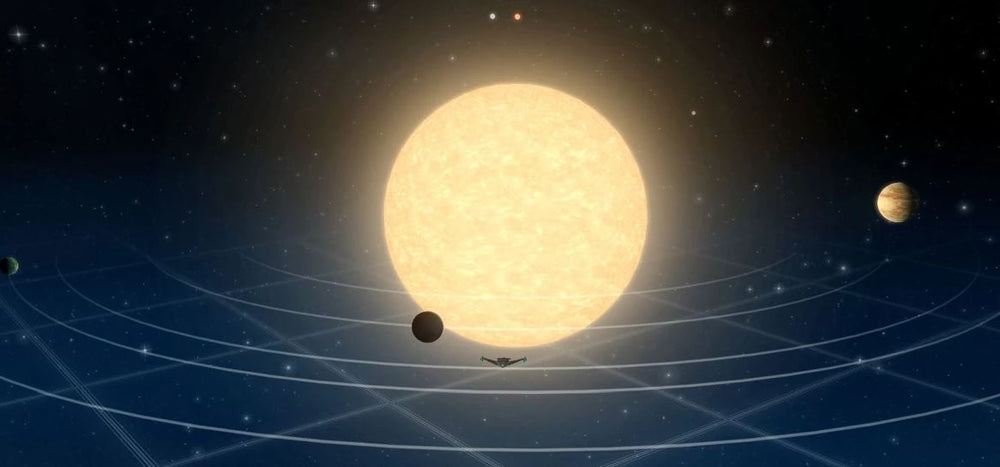Pollux Star: Type, Age, Size, Diameter, Mass, Temperature, Color and Distance from Earth
The universe is a vast and mysterious place, filled with countless celestial objects that continue to intrigue and fascinate us. One such object is the Pollux star, a bright and unique star located in the constellation Gemini. In this blog post, we will explore everything you need to know about the Pollux star.
What is the Pollux star?
The Pollux star, also known as Beta Geminorum, is a bright orange giant star located in the constellation Gemini. It is one of the brightest stars in the constellation and is visible to the naked eye. Pollux is approximately 34 light-years away from Earth, making it a relatively close star in astronomical terms.
Pollux is classified as an orange giant star, which means that it is a star that has exhausted most of the hydrogen in its core and is now fusing helium into heavier elements. This process causes the star to expand and become brighter, resulting in the characteristic orange color of the star.

History of the Pollux star
The Pollux star has been known since ancient times and has been referred to by various names throughout history. In Greek mythology, Pollux and Castor were known as the Dioscuri, or "sons of Zeus." In Arabic astronomy, Pollux was known as "Al-Dhira," which means "the arm."
Characteristics of the Pollux star
The Pollux star is an orange giant star that is approximately 9 times larger than the Sun and approximately 50 times more luminous. It has a surface temperature of approximately 4,600 Kelvin and a mass estimated to be around 1.8 times that of the Sun.
Pollux is also known for its relatively high metallicity, which means that it contains a higher proportion of elements heavier than helium compared to the Sun. This is believed to be the result of the star's age, as older stars tend to have higher metallicity due to the accumulation of heavier elements over time.

Pollux Star Type
Pollux is classified as a red giant star, a stellar phase that occurs later in the lifecycle of many stars.
Pollux Star Age
The age of Pollux star offers a glimpse into its cosmic journey. With an estimated age of around 724 million years, it has traversed a considerable portion of its stellar evolution, transitioning from its earlier stages to its current phase.
Pollux Star Size
The size of Pollux star, a captivating red giant, showcases the awe-inspiring dimensions that stars can attain during their evolution. Once a star with a size comparable to our Sun's, Pollux has transformed into a cosmic giant in its red giant phase. With an estimated radius of approximately 13.9 million kilometers (8.6 million miles), Pollux has expanded to several times its original size. This remarkable transformation is a result of the star's outer layers expanding outward as it undergoes profound changes internally. As we gaze upon Pollux's expanded dimensions, we are reminded of the dynamic and ever-changing nature of the universe, where stars evolve and transform in ways that continue to captivate our imagination.
Pollux Star Diameter
The diameter of Pollux star, a captivating red giant, offers a window into the majestic transformations that stars undergo throughout their lifecycles. Once a star with a diameter similar to that of our Sun, Pollux has embarked on a journey of cosmic expansion as it progresses into its red giant phase. Its current estimated diameter is approximately 10.12 million kilometers (6.28 million miles), showcasing the remarkable changes that occur within the heart of a star. Contemplating Pollux's expanded dimensions evokes a sense of wonder about the vast and intricate processes at play in the celestial symphony of the universe.
Pollux Star Mass
Mass, a fundamental characteristic of stars, plays a vital role in shaping their behavior and fate. Pollux star's mass, estimated to be about 1.8 times that of our Sun, contributes to its unique properties and the processes occurring within its core.
Pollux Star Temperature
The temperature of a star is a direct reflection of the energy it radiates into the cosmos. Pollux's surface temperature, around 4,860 degrees Celsius (8,800 degrees Fahrenheit), bestows upon it a warm radiance that graces the night sky.
Pollux Star Color
Color is a captivating feature of stars, providing insights into their characteristics. Pollux star's color, a striking reddish-orange hue, is a hallmark of its red giant status. This unique color distinguishes it amidst the celestial array.
Pollux Star Distance from Earth
Pollux star, a beacon in the constellation Gemini, is situated at an approximate distance of 33.78 light-years from our planet. This celestial proximity allows it to cast its gentle glow upon our night sky, forming a part of the cosmic tapestry we admire.
Pollux Star
Here's a detailed specification table for Pollux star, highlighting its key characteristics:
| Characteristic | Pollux Star |
|---|---|
| Star Type | Red Giant |
| Age (approx.) | ~724 million years |
| Size (expanded) | Several times larger than Sun |
| Mass (relative to Sun) | ~1.8 times |
| Surface Temperature | ~4,860°C (8,800°F) |
| Spectral Color | Reddish-Orange |
| Distance from Earth | ~33.78 light-years |
Importance of the Pollux Star
The Pollux star is an important object of study for astronomers as it provides valuable insights into the processes that occur in aging stars. The star's orange giant phase is a critical stage in its evolution and studying Pollux can help scientists better understand the processes that occur in other stars as they approach the end of their lives.
Additionally, the Pollux star is a useful tool for measuring distances in the universe. By studying the light emitted by the star, astronomers can determine its distance from Earth and use this information to calculate the distances of other celestial objects.

How to observe the Pollux star
Observing the Pollux star is relatively easy as it is visible to the naked eye. The best time to observe the star is during the winter months when the constellation Gemini is at its highest point in the sky.
To find the Pollux star, locate the bright star in the head of the constellation Gemini. Pollux has an orange color and is the brightest star in the constellation. With binoculars or a telescope, it is possible to see the star's orange color and its size relative to other stars in the sky.

Pollux star
Below is a detailed table comparing the characteristics of the Pollux star to those of the Sun:
| Characteristic | Pollux | Sun |
|---|---|---|
| Spectral Type | K0 III | G2V |
| Mass (solar masses) | 1.8 | 1 |
| Radius (solar radii) | 9 | 1 |
| Luminosity (solar luminosities) | 50 | 1 |
| Surface Temperature (Kelvin) | 4,600 | 5,500 |
| Age (millions of years) | 724 | 4.6 |
| Rotation Speed (km/s) | 2.8 | 2 |
| Distance from Earth (light-years) | 34 | 1 |
As the table shows, the Pollux star is much larger and more luminous than the Sun, with a radius of approximately 9 solar radii and a luminosity estimated to be around 50 times greater. The star is also much older than the Sun, estimated to be around 724 million years old.
In terms of spectral type, the Pollux star is classified as a K0 III star, which means that it is an orange giant star that has exhausted most of the hydrogen in its core and is now fusing helium into heavier elements. The Sun, on the other hand, is classified as a G2V star, which means that it is a yellow dwarf star that is still fusing hydrogen in its core.
The Pollux star's relatively high metallicity is also evident in the table, with the star's estimated metallicity being approximately 2.5 times greater than that of the Sun.

Pollux vs Sun
Pollux, a luminous orange giant star nestled in the Gemini constellation, offers a remarkable departure from our own Sun. With a spectral class of K0 III, Pollux radiates a warm orange glow that distinguishes it from the Sun's G-type main-sequence classification. In terms of size, Pollux outshines the Sun with a diameter approximately 9 times larger. However, its expanded size doesn't translate to greater luminosity, as the Sun's energy output far exceeds that of Pollux. Dive into the comprehensive comparison table below to uncover the distinct attributes that set Pollux and the Sun apart.
| Characteristic | Pollux | Sun |
|---|---|---|
| Spectral Class | K0 III | G2 V |
| Diameter | ~9 times larger than the Sun | - |
| Luminosity | Lesser than the Sun | - |
| Temperature | Cooler than the Sun | - |
| Life Stage | Orange giant phase | Main-sequence star |
| Constellation | Gemini | N/A |
Pollux, an K0 III orange giant, radiates its warmth through its expansive size and inviting orange hue. In contrast, the Sun, a G2 V main-sequence star, symbolizes the steady core of our solar system. Although Pollux's diameter is considerable, its luminosity falls behind the Sun's exceptional energy output, emphasizing the intricate balance between size and radiance. With Pollux's cooler temperature, the interplay between size and heat further underscores the complexities of stellar dynamics. Exploring these differences fosters a deeper appreciation for the wide array of stars that contribute to the breathtaking spectacle of the cosmos.
Conclusion
The Pollux star is a fascinating object in the universe that provides valuable insights into the processes that occur in aging stars. Whether you are an astronomy enthusiast or simply curious about the wonders of the universe, Pollux is definitely worth observing. Its unique characteristics, such as its orange color, high metallicity, and advanced age, make it an important object of study for scientists seeking to understand the processes that occur in aging stars.
As our understanding of the Pollux star continues to evolve, it is likely that we will uncover even more mysteries and insights into the universe. The study of stars such as Pollux reminds us of the infinite possibilities that exist in the universe, and the importance of continuing to explore and learn about the wonders that surround us.
More Star Topics:
- How are stars formed?
- The life cycle of a star
- How many Stars are in the milky way
- Where is the north star
- 3 stars in a row in the sky
- What is an open star cluster
- What is a red giant star
- What is a white dwarf star
- What is a neutron star

